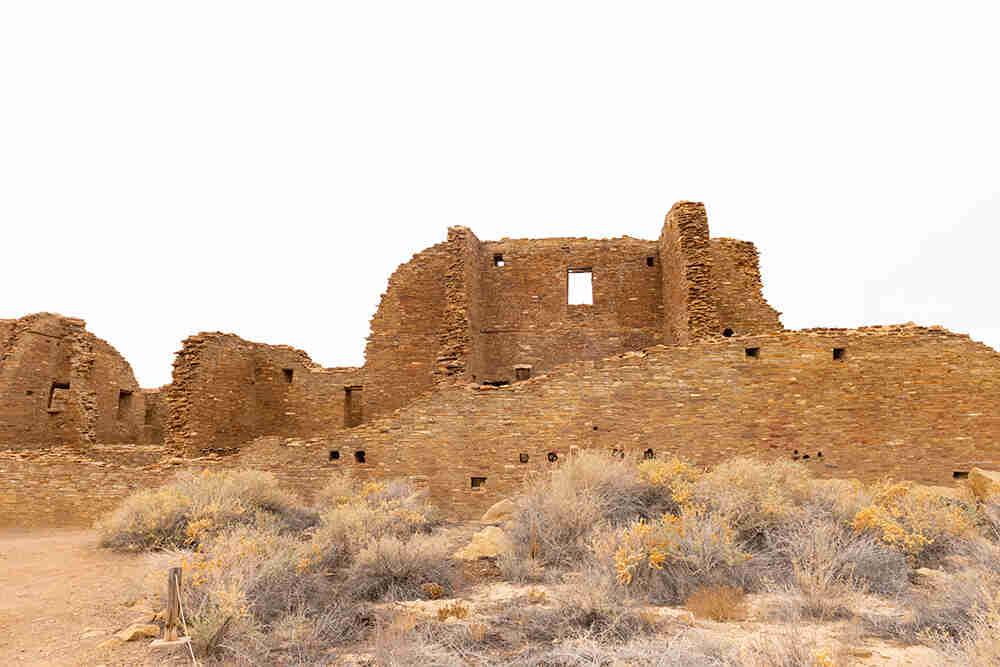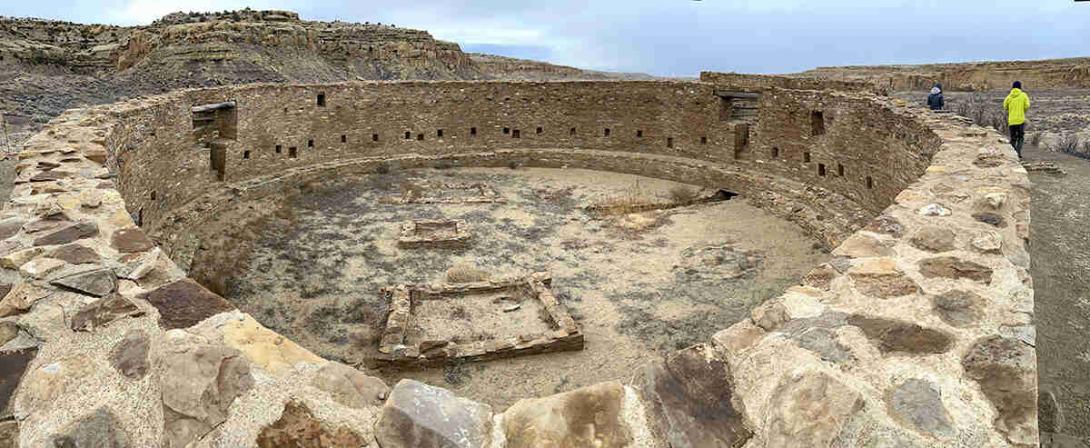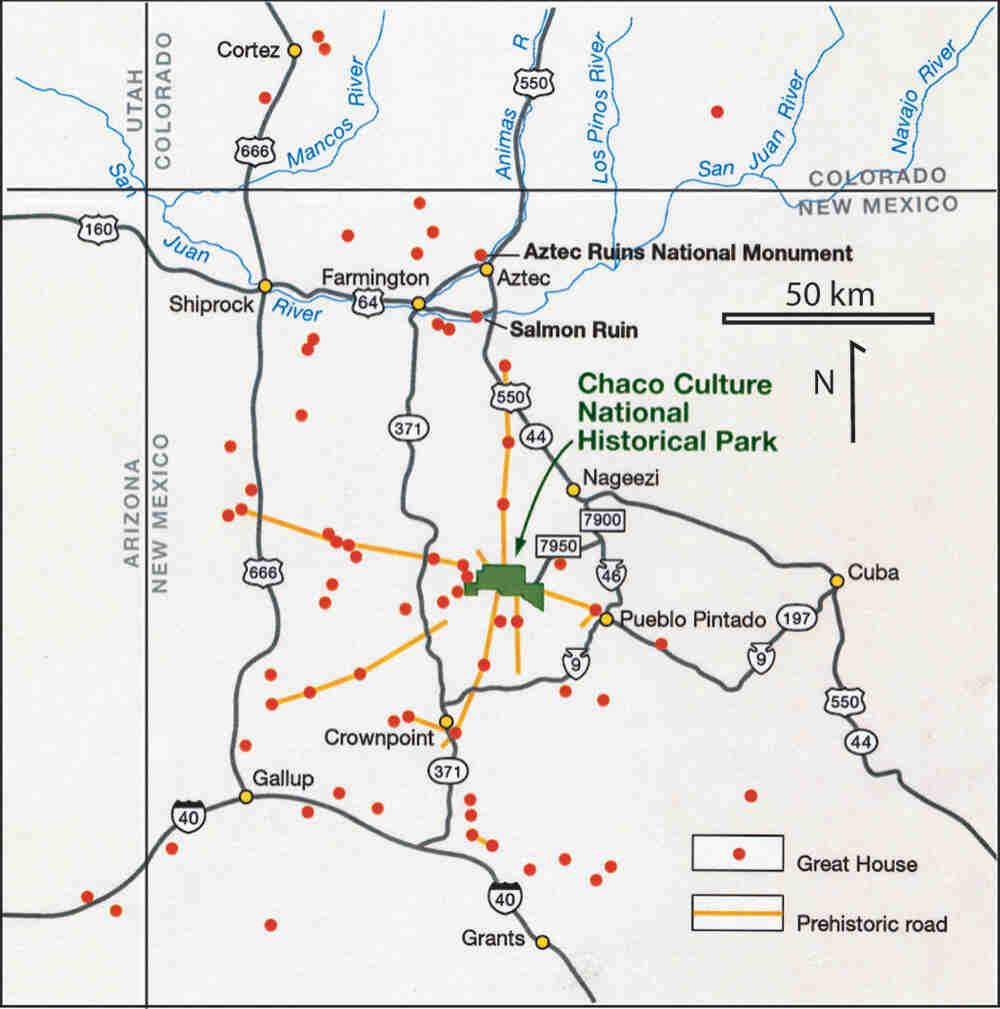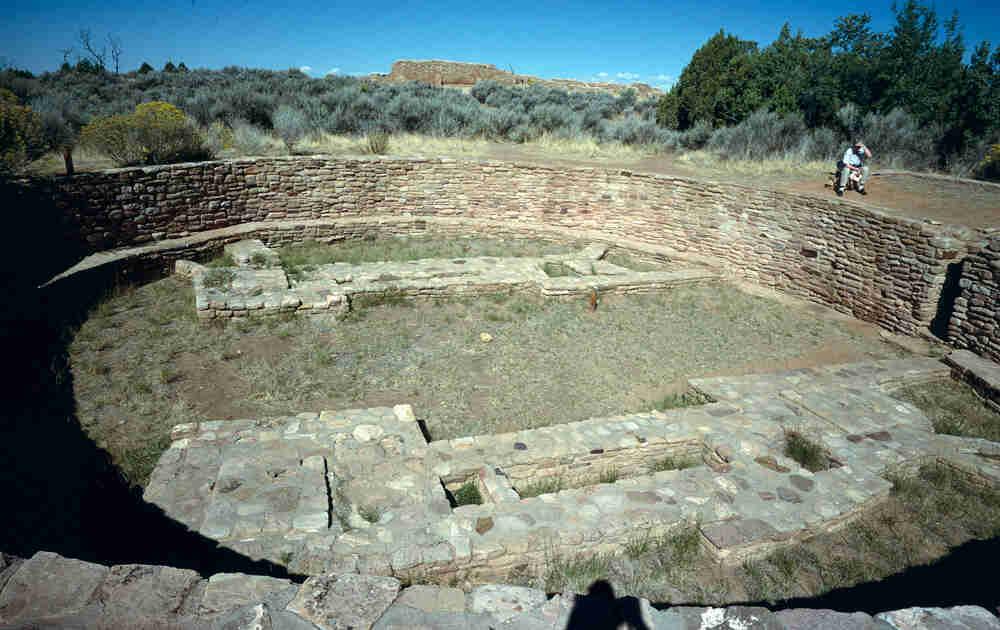Chaco Canyon
Full Article
In the eleventh century, Chaco Canyon in northwestern New Mexico was the center of a Native American cultural region about the size of the state of Indiana. It encompassed most of southwestern Colorado, from Chimney Rock National Monument on the east to Far View House at Mesa Verde National Park and Canyons of the Ancients National Monument on the west.
Chaco Canyon was made a National Park and a World Heritage Site because of its remarkable Great Houses: monumental stone masonry buildings much larger and far more formal than any other architecture in the ancient Southwest. At its height, about AD 1100, Chaco was the largest and most complex Ancestral Pueblo site.
Chaco Canyon
The heart of Chaco Canyon is a seven and one-half-mile long stretch with the intermittent Chaco Wash running from east-southeast to west-northwest toward the San Juan River. The north side of the canyon has towering sandstone cliffs topped by wide, slickrock terraces; the south side is less dramatic. The largest great houses were concentrated in a “downtown” zone a little more than a mile wide at the center of Chaco Canyon. The scale of Chaco’s world was even larger, however, extending over much of the Four Corners region, as far away as 155 miles from Chaco Canyon. Extrapolating from demographic data for the northern third of the Chaco region and from ranges of outlier community sizes, the Chaco region comprised perhaps 30,000 to 40,000 people, of whom only a few thousand at most resided in great houses. Chaco itself was a capital city, the seat of political power.
Chaco Canyon’s environment was harsh. Summers are blisteringly hot and very dry, and winters are wretchedly cold. The growing season is short, and rainfall is uncertain. Water for basic domestic needs was—and remains—a concern. The canyon contained little wood for building or burning, and no outstanding local resources besides sandstone and petrified wood, which was useful for tools. Because the canyon was a poor place to farm, inhabitants imported much or most of their staple foods—maize, beans, and squash, as well as meat from large game animals—from better-watered areas around the edge of Chaco’s region. How and why did Chaco’s spectacular great houses flourish in this desert canyon, when well-watered valleys lay all but empty to the north and south, closer to mountains and forests? The answers to those questions must be sought outside the canyon itself, in the larger region of which Chaco was the center.
The archaeology of Chaco Canyon centers on a dozen remarkable buildings called great houses. Great houses at Chaco began in the late ninth century AD as monumentally upscaled versions of regular domestic structures, unit pueblos—the small, single-family home or, more prosaically, “small sites.” Early great houses were unquestionably residences, and they continued to be used as residences, even if that basic function was obscured by the addition of warehouses and other non-domestic functions over the next three centuries.
In the Chaco region there were scores of unit pueblos for every great house. An entire unit pueblo, compressed to its floor area, would fit in a large room at a great house. Unit pueblos and great houses constitute one of the clearest examples of stratified housing in archaeology, and a clear indication of a class society. In Mesoamerican terms, great houses were the palaces of noble families; unit pueblos were the farmsteads of commoners.
Great Houses
Shortly after AD 1000, great houses became monuments in addition to elite residences. The traditional curved plans of earlier great houses were replaced by precise, formal geometries. Great house plans are typically described by letters: “D”-shaped, “E”-shaped, and so forth. Vast blocks of storage rooms, disproportionate to the small numbers of great house residents, were added, as were monumental public and official spaces. Most of Chaco’s great houses were built along the north side of the canyon in little over a century, from AD 1020 to about AD 1125; but each great house has a unique construction history, and several started much earlier. Pueblo Bonito was one of the earliest great houses and is typical—perhaps archetypical—of Chaco Canyon great houses.
Pueblo Bonito took almost three centuries (AD 850 to AD 1125) to build. Like other great houses, Pueblo Bonito was expensive and laborious to build; the labor-per-unit measure of floor area or roofed volume far exceeded that for unit pueblos, which were built and maintained by their resident families. Every stage of construction was monumental, meant to be seen and appreciated. Beginning about CE 1020, the architects of Pueblo Bonito started a series of six major additions, each of which was enormously larger than anything previously built in the Pueblo world. At the culmination, about CE 1125, almost 700 rooms, massed up to four and perhaps five stories tall, covered an area of about two acres. Along the front of the enclosed plaza, two dozen kivas (round rooms with both domestic and ritual functions) were built above and below grade. Only a score of families actually lived in this huge building. They were important families who controlled, or at least had access to, vast blocks of storage and non-domestic rooms.
Great houses served the dead as well as the living. The earliest part of Pueblo Bonito, the cluster of earliest rooms at the center of the building, became a mausoleum for elite burials. Two high-status middle-aged men—perhaps the building’s founders—were buried in AD 850 with great wealth in wooden crypts beneath the building’s floor. These honored dead defined one aspect of the great house’s monumentality. Later construction preserved the early core with its burials, enveloping the older masonry in better-built blocks of rooms. Many more elite deceased were later richly interred in the oldest parts of the building.
In contrast, burials at unit pueblos were typically in middens fronting the homestead, accompanied by a ceramic pot or two. Scores of unit pueblos and aggregates of such units—commoner homes—lined the south side of the canyon. These homes were identical to farmsteads throughout Chaco’s region and in regions beyond Chaco’s reach: single (extended) family homes, largely self-sufficient, clustered into scattered communities of a few dozen unit pueblos and with a central great kiva, with a total population of a few hundred people. That was the social scale of ancient settlements, before Chaco.
Pueblo Bonito was only one of a half-dozen major great houses at Chaco. There were many smaller great houses, mostly built on the north side of the canyon. Great houses were part of a large, complex settlement; in effect, a city (described below). “Downtown” Chaco as a built environment or cityscape encompassed many other elements, such as roads, mounds, great kivas, waterworks, and hundreds of unit pueblos on the south side of the canyon, each consisting of five or six rooms and a pit house.
Roads and Waterworks
Chacoan roads were carefully engineered earthen features, typically long, straight, and about twenty-seven-feet wide. They linked Chaco Canyon to other Chacoan sites and to important natural features, extending outward like spokes on a wheel. Some led to distant great houses; others lead to important natural features. Roads are evident at two of Colorado’s two dozen Chacoan outliers: Lowry Pueblo and Far View House. An elaborate and extensive line-of-sight communication system, with signal fire stations atop high points, paralleled the road system, allowing information to pass to and from Chaco to the edges of its region relatively quickly.
The north side of Chaco Canyon was lined with small-scale waterworks, capturing rare rainfall in bedrock reservoirs atop the cliffs and channeling it to small fields. These systems have been interpreted as subsistence infrastructure, but given the poor agricultural prospects and the clear monumentality of Chaco Canyon, it seems possible that water was an element of landscape architecture, irrigating gardens between great houses.
The Chaco Region
As Chaco’s roads and imported food suggest, its sphere of influence extended far beyond the confines of Chaco Canyon. It was the center of a large regional system of about 30,000 square miles, defined by about 150 smaller “outlier” great houses, road networks, and line-of-sight signaling systems.
Small outlier great houses used the same techniques and design principles as Chaco Canyon great houses, but the outliers were typically about one-twentieth the size of buildings such as Pueblo Bonito, as if a portion of those buildings had been cut away and transplanted over great distances. Lowry Pueblo is one of these outliers, located almost 125 miles from Chaco Canyon. Almost always, the great house sat amid (usually above) a scattered community of a score or more unit pueblos. Outlier great houses might represent direct imposition of Chacoan forms and presumably people, or they could represent local copies or emulations of Chacoan styles. In either case, great house residents were identified with Chaco.
What was Chaco?
Archaeological interpretations of Chaco Canyon range from a valley with a half-dozen farming villages (“pueblos”), to a ceremonial pilgrimage center, to the capital of a small city-state. The people of Chaco Canyon were ancestors of modern Pueblo Indian tribes, who today live in about forty traditional farming villages in New Mexico and Arizona. Pueblo Indian traditions reference Chaco and its history, as a place where various clans resided in the migrations that eventually led to Pueblos such as Hopi, Zuni, and Acoma (among others). Many archaeologists interpret Chaco as if its great houses were like modern Pueblos: egalitarian, communal, independent farming villages. Other archaeologists recognize that historic and modern Pueblos do not have a single regional center; each Pueblo is independent. While certainly a place and event in Pueblo history, Chaco was probably more than a cluster of farming villages—it was likely an episode of political centralization at odds with modern Pueblo ways of life; modern Pueblo societies developed partly in reaction to and rejection of Chaco.



























